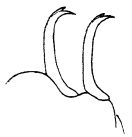Isohypsibioidea from Marley et al. 2011: “Parachela. Claws asymmetrical (2121); Isohypsibius-type claw pairs; AISM ridged.”
Isohypsibioidea from Bertolani et al. 2014: “Double claws asymmetrical with respect to the median plane of the leg (2121), normally with similar shape and size on each leg; double claws of the Isohypsibius type (secondary branch of the external claw inserted perpendicularly on the claw basal tract), or reduced from it: Hexapodibius type (very short, without common basal tract, with a base as large as the sum of the primary and secondary branch widths, and with an evident suture between primary and secondary branch); Haplomacrobiotus type (one branch only); completely absent (Apodibius). Buccal tube completely rigid (apart Paradiphascon; see below) and often relatively large, without (Dastychius, Eremobiotus, Halobiotus, Isohypsibius, Paradiphascon, Pseudobiotus, Thulinius) or with (Apodibius, Doryphoribius, Haplomacrobiotus, Haplohexapodibius, Hexapodibius, Parhexapodibius) ventral lamina. Eggs with smooth shell laid within the exuvium.”
Hexapodibiidae from Cesari et al. 2016: “Double claws asymmetrical with respect to the median plane of the leg (2121), or with only the mainbranch, with the secondary branch being reduced or sometimes absent on some legs. Claws of Hexapodibius type very short and without a common basal tract, with a base as large as the sum of primary and secondary branch widths, and with an evident suture between the primary and the secondary branch; claws of Haplomacrobiotus type with one branch only, eventually with small spurs on the fourth pair of legs. Lunules and other cuticular thickenings absent on the legs in the known species. Peribuccal lobes and peribuccal papulae present. Buccal–pharyngeal apparatus of the Hexapodibius type (according to Pilato & Binda, 2010) with a completely rigid buccal tube and with a ventral lamina; pharyngeal apophyses and placoids present in the known species. Eggs with smooth shells, laid within the exuvia”
Genus description from May 1948: “… la présence de deux griffes simples…”
Translated: “…presence of two simple claws…”
Note: May describes simple claws (lacking secondary branches) on all eight legs; Ramazzotti & Maucci report this on the first three legs only, with a tiny secondary branch on legs IV, barely visible (not from May, perhaps based on Pilato 1973). But Pilato & Beasley 2005 describe a Haplomacrobiotus with 8 simple claws.



Citations:
Bertolani R, Guidetti R, Marchioro T, Altiero T, Rebecchi L, Cesari M. 2014. Phyloeny of Eutardigrada: New molecular data and their morphological support lead to the identification of new evolutionary lineages. Molecular Phylogenetics and Evolution. 76: 110-126.
Cesari M, Vecchi M, Palmer A, Bertolani R, Pilato G, Rebecchi L, Guidetti R. 2016. What if the claws are reduced? Morphological and molecular phylogenetic relationships of the genus Haplomacrobiotus May, 1948 (Eutardigrada, Parachela). Zoological Journal of the Linnean Society. 178: 819-827.
Marley NJ, McInnes SJ, Sands CJ. 2011. Phylum Tardigrada: A re-evaluation of the Parachela. Zootaxa. 2819: 51-64.
May RM. 1948. Nouveau genre et espèce de tardigrade du Mexique: Haplomacrobiotus hermosillensis. Bulletin de la Société zoologique de France. 73: 95-97.















